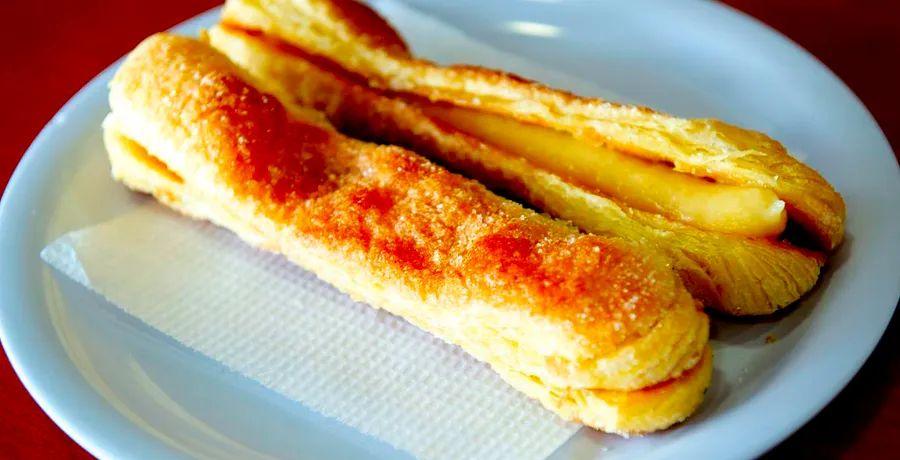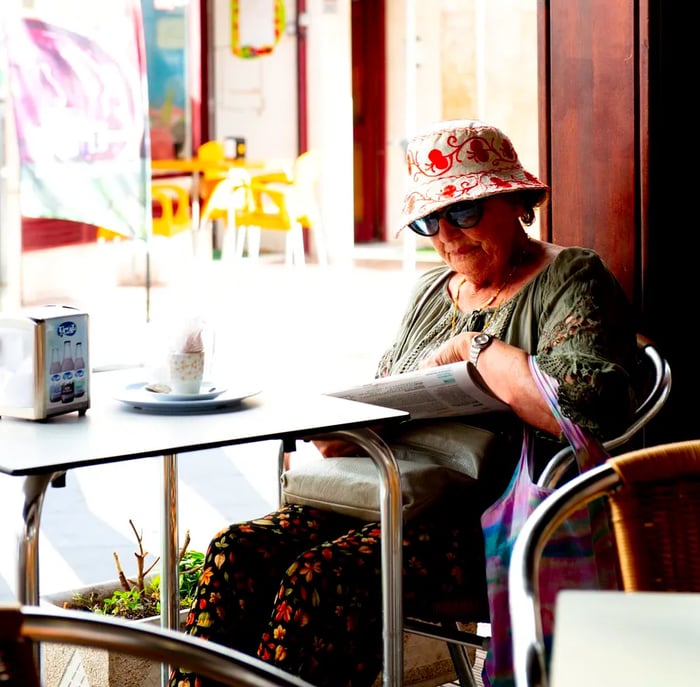To experience Portugal’s ultimate pastry, make your way to the beach

Many visitors to Lisbon never venture beyond the city center, captivated by the stunning tiled buildings, quaint cobblestone streets, and the irresistible pastéis de nata found on every corner. Few are willing to cross the iconic 25 de Abril Bridge to explore Costa da Caparica and dip their toes in the soft sands of its beaches. This is perfectly fine for the locals; it means more claudinos for them.
This elongated, flaky pastry filled with creamy goodness is a staple on the southern bank of the Tagus River. It first appeared at the local pastry shop Papo-Seco before making its way to other nearby establishments. Today, Pastelaria O Capote is the renowned destination, often drawing long lines outside its door on warm summer days. The claudino has even made its way across the river to Lisbon, where it finds a place among the city’s already abundant array of sweets, much like the colorful azulejos adorning its historic walls.
While you might encounter one during your Lisbon tour, the best experience of a claudino is to savor it in its original setting in Costa da Caparica.
 A patron savoring her coffee at O Capote.
A patron savoring her coffee at O Capote. The pastry display case at O Capote.
The pastry display case at O Capote.What exactly is a claudino?
Like many Portuguese desserts, claudinos blend sugar and egg yolk into a luxurious pastry cream, complemented by warm milk and a starch for stability. However, unlike traditional pastries that trace back to monasteries or convents, claudinos were born in the 1980s when an unnamed pastry chef at Papo-Seco experimented by sprinkling sugar on puff pastry before baking and using pastry cream as a filling. The outcome exceeded expectations and quickly won the hearts of locals. When Papo-Seco shut down a decade later, some of the original bakers moved to O Capote down Rua dos Pescadores, bringing the claudino recipe with them.
Portuguese pastries, including the much-loved pastéis de nata, are crafted to complement coffee, providing a delightful sugar boost. This holds true for claudinos as well. However, the modern claudino has a unique edge over its traditional round counterpart: according to Magda Costa, manager of O Capote, it is 'the perfect shape to enjoy with a coffee in the other hand.'
Designer Rita João, editor of Fabrico Proprio: The Design of Portuguese Semi-Industrial Confectionery, concurs, stating that 'a claudino features a narrower, more anatomical and ergonomic shape, making it easy to hold and a perfect fit for the mouth.' She notes that the recipe at O Capote is a variation of the traditional parra, shaped in a style inspired by French éclairs.

João explains, 'With less surface area compared to a parra, the pastry bakes evenly.' Its long, slender design and open side also facilitate the addition of the handmade filling, avoiding the semi-industrial egg creams prevalent in many sweets across the country. Using puff pastry rather than the typical pâte à choux found in French pastries means the claudino isn't as hollow as an éclair, allowing for a better balance of dough and cream. The innovation at Papo-Seco of sprinkling sugar on the dough before baking creates a glossy finish. 'It’s a winning combination of shape, textures, and flavors,' João states.
Claudinos draw people from all over, especially in summer when Costa da Caparica is swarmed with tourists. However, these pastries are not just a seasonal delight. Costa notes, 'It’s our flagship item all year round. There isn’t a single day that we don’t sell at least one.' The claudino's popularity has soared to the point where O Capote now takes orders for giant claudinos weighing up to two kilos to serve as birthday cakes.
It’s no surprise that claudinos have carved out a place on the display counters of pastry shops in downtown Lisbon. A Tentadora, a café established in 1912 in the Campo de Ourique area, introduced claudinos six years ago, and these treats now account for 10 percent of their daily sales. Manager Carlos Faria notes, 'More and more customers are asking for a claudino here. They know we make them and seek them out.'
While the original recipe remains a closely guarded secret at O Capote, a general formula has emerged among rival shops—though some choose to fill their pastries with egg cream instead.
 Outside of O Capote.
Outside of O Capote.Where to find one
O Capote
Fresh batches of claudinos are baked at O Capote throughout the day. Visit in the morning to pair one with a meia de leite, the local version of coffee with milk. Or drop by in the afternoon for a claudino, the perfect snack after a day at the beach. 40 Rua dos Pescadores, Costa da Caparica, 2825-386
Pastelaria Copacabana
Located on the same street as O Capote, Pastelaria Copacabana has been a fixture in Costa da Caparica for fifty years. Like its renowned neighbor, it offers claudinos filled with traditional pastry cream. Pastry chef Joaquim Pires starts his day at 3 a.m. to ensure the pastries are crisp for the first customers. 3-4 Rua dos Pescadores, Costa da Caparica, 2825-345
Xandite
Established in 1970, Xandite operates three locations in Costa da Caparica. The original spot on Rua Dom João features charming hand-painted tiles adorning the walls. The chain centralizes its production in a main kitchen, ensuring fresh claudinos (filled with egg cream) are delivered each morning—but they sell out quickly. 11 R. Dom João VI, Costa da Caparica, 2825-322
Rafael Tonon is a journalist and food writer based in Brazil and Portugal. He is the author of The Food Revolutions.
Humberto Mouco is a Portuguese photographer residing in Lisbon. He has been professionally capturing images, particularly portraits and food, since 1994.

1

2
3

4

5
Evaluation :
5/5